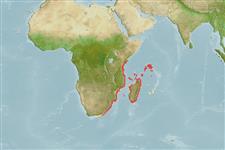>
Scombriformes (Mackerels) >
Scombridae (Mackerels, tunas, bonitos) > Scombrinae
Etymology: Scomberomorus: Latin, scomber = mackerel + Greek, moros = silly, stupid (Ref. 45335).
Environment: milieu / climate zone / depth range / distribution range
Ecologia
marinhas; oceanódromo (Ref. 51243); intervalo de profundidade 50 - 200 m. Subtropical; 1°S - 37°S, 23°E - 59°E (Ref. 168)
Western Indian Ocean: Seychelles, Kenya and Zanzibar to South Africa and along the west coast of Madagascar. This species has been confused with Scomberomorus lineolatus and with Scomberomorus guttatus (and also one of its junior synonyms Scomberomorus leopardus).
Length at first maturity / Tamanho / Peso / Idade
Maturity: Lm ?, range 80 - ? cm
Max length : 120 cm FL macho/indeterminado; (Ref. 168); peso máx. Publicado: 12.5 kg (Ref. 40637)
Espinhos dorsais (total): 15 - 17; Raios dorsais moles (total): 19-21; Raios anais moles: 19 - 22; Vértebras: 45 - 46. Interpelvic process small and bifid. Body covered with small scales. Lateral line without auxiliary branches anteriorly, gradually curving down toward caudal peduncle. Intestine with 2 folds and 3 limbs. Juveniles have spots but develop adult pattern of interrupted lines by the time they reach 40 cm.
Neritic species (Ref. 5313). Forms large schools in the Zanzibar Channel from March to September. Feeds mainly on anchovies (Anchoviella sp.), clupeids (Amblygaster sp., Sardinella fimbriata, Sardinella perforata [= Sardinella albella), other small fishes, squids, and mantis shrimps.
Life cycle and mating behavior
Maturidade | Reprodução | Desova | Ovos | Fecundidade | Larvas
Collette, B.B. and C.E. Nauen, 1983. FAO Species Catalogue. Vol. 2. Scombrids of the world. An annotated and illustrated catalogue of tunas, mackerels, bonitos and related species known to date. Rome: FAO. FAO Fish. Synop. 125(2):137 p. (Ref. 168)
Categoria na Lista Vermelha da IUCN (Ref. 130435)
Ameaça para o homem
Harmless
Utilização humana
Pescarias: espécies comerciais; peixe desportivo: sim
Mais informação
ReferênciasAquaculturaPerfil para aquaculturaEstirpesGenéticaElectrophoresesHereditariedadeDoençasProcessamentoNutrientsMass conversion
ColaboradoresFotografiasStamps, Coins Misc.SonsCiguateraVelocidadeTipo de nataçãoÁrea branquialOutras referênciasCérebrosVisão
Ferramentas
Relatórios especiais
Descarregue XML
Fontes da internet
Estimates based on models
Preferred temperature (Ref.
123201): 20.4 - 25.4, mean 21.8 °C (based on 19 cells).
Phylogenetic diversity index (Ref.
82804): PD
50 = 0.5000 [Uniqueness, from 0.5 = low to 2.0 = high].
Bayesian length-weight: a=0.00871 (0.00443 - 0.01714), b=3.01 (2.85 - 3.17), in cm total length, based on LWR estimates for this species & Genus-body shape (Ref.
93245).
Nível Trófico (Ref.
69278): 4.2 ±0.77 se; based on food items.
Generation time: 1.9 ( na - na) years. Estimated as median ln(3)/K based on 1
growth studies.
Resiliência (Ref.
120179): Médio, tempo mínimo de duplicação da população 1,4 - 4,4 anos (tm=2).
Fishing Vulnerability (Ref.
59153): Moderate vulnerability (39 of 100).
Nutrients (Ref.
124155): Calcium = 20.3 [8.9, 71.4] mg/100g; Iron = 0.893 [0.392, 2.210] mg/100g; Protein = 21.3 [20.0, 22.6] %; Omega3 = 0.411 [0.259, 0.665] g/100g; Selenium = 36.9 [13.0, 113.7] μg/100g; VitaminA = 9.34 [2.03, 46.45] μg/100g; Zinc = 0.419 [0.273, 0.700] mg/100g (wet weight);
